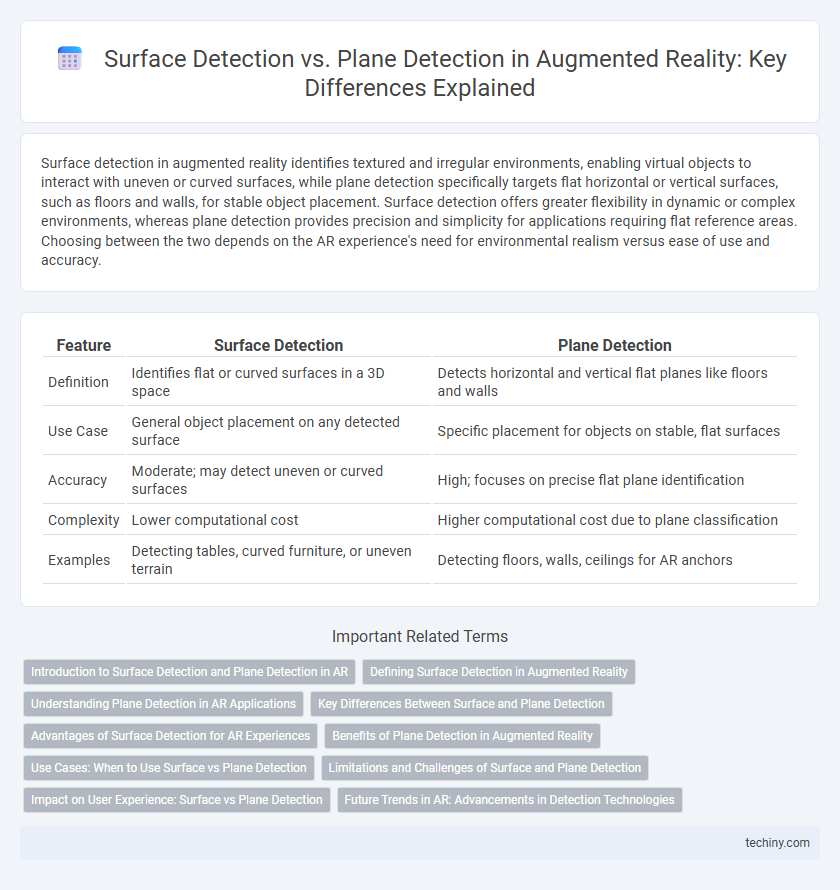Surface detection in augmented reality identifies textured and irregular environments, enabling virtual objects to interact with uneven or curved surfaces, while plane detection specifically targets flat horizontal or vertical surfaces, such as floors and walls, for stable object placement. Surface detection offers greater flexibility in dynamic or complex environments, whereas plane detection provides precision and simplicity for applications requiring flat reference areas. Choosing between the two depends on the AR experience's need for environmental realism versus ease of use and accuracy.
Table of Comparison
| Feature | Surface Detection | Plane Detection |
|---|---|---|
| Definition | Identifies flat or curved surfaces in a 3D space | Detects horizontal and vertical flat planes like floors and walls |
| Use Case | General object placement on any detected surface | Specific placement for objects on stable, flat surfaces |
| Accuracy | Moderate; may detect uneven or curved surfaces | High; focuses on precise flat plane identification |
| Complexity | Lower computational cost | Higher computational cost due to plane classification |
| Examples | Detecting tables, curved furniture, or uneven terrain | Detecting floors, walls, ceilings for AR anchors |
Introduction to Surface Detection and Plane Detection in AR
Surface detection in augmented reality identifies various textured and uneven real-world surfaces, enabling virtual objects to interact naturally with complex environments. Plane detection specifically targets flat horizontal or vertical surfaces such as floors, walls, and tables, providing reliable anchor points for virtual content placement. Both techniques utilize advanced computer vision algorithms and sensor data to enhance spatial understanding and immersive AR experiences.
Defining Surface Detection in Augmented Reality
Surface detection in augmented reality refers to the technology's ability to identify and map real-world objects and textures that may not be flat, enabling interaction with curved, irregular, or composite surfaces. This detection process utilizes sensors and computer vision algorithms to create a detailed spatial understanding beyond simple geometric planes. Unlike plane detection, which isolates flat horizontal or vertical surfaces, surface detection supports more complex and immersive AR experiences by recognizing diverse environmental features.
Understanding Plane Detection in AR Applications
Plane detection in augmented reality (AR) identifies flat surfaces such as floors, walls, and tables by analyzing spatial data from device sensors like cameras and LiDAR. This process enables AR applications to accurately place virtual objects on real-world surfaces, enhancing interaction and realism. Unlike general surface detection, plane detection specifically targets horizontal and vertical planes, providing a more precise foundation for immersive AR experiences.
Key Differences Between Surface and Plane Detection
Surface detection in augmented reality identifies irregular and complex shapes such as curved or uneven surfaces, while plane detection focuses specifically on flat, horizontal, or vertical planes like floors, walls, and tables. Surface detection uses advanced algorithms to map detailed geometries, enabling interaction with diverse textures and contours, whereas plane detection simplifies the environment into basic geometric shapes for easier object placement and spatial understanding. Understanding these distinctions enhances AR application accuracy and user experience by tailoring interaction models to the detected spatial features.
Advantages of Surface Detection for AR Experiences
Surface detection in augmented reality offers enhanced environmental understanding by identifying complex and irregular surfaces, unlike traditional plane detection which is limited to flat, horizontal or vertical planes. This capability allows AR applications to anchor virtual objects more accurately on curved, textured, or uneven surfaces, improving realism and user immersion. By providing greater flexibility in object placement, surface detection expands the scope of interactive AR experiences across diverse real-world environments.
Benefits of Plane Detection in Augmented Reality
Plane detection in augmented reality enhances spatial understanding by accurately identifying flat surfaces such as floors, tables, and walls, enabling stable and realistic placement of virtual objects. This precise surface recognition improves user interaction by allowing consistent anchoring of AR content, reducing jitter and drift compared to basic surface detection techniques. Enhanced environmental mapping through plane detection facilitates immersive experiences and supports complex applications like interior design, gaming, and navigation.
Use Cases: When to Use Surface vs Plane Detection
Surface detection excels in complex environments with irregular or curved objects, enabling robust interaction in gaming and interactive art installations. Plane detection is ideal for applications requiring flat, stable surfaces like furniture placement in interior design apps or navigation aids in industrial settings. Choosing between surface and plane detection depends on the need for precision in object placement versus adaptability to varied geometric shapes.
Limitations and Challenges of Surface and Plane Detection
Surface detection in augmented reality often struggles with accurately identifying irregular or reflective surfaces, leading to inconsistent virtual object placement. Plane detection is generally limited to recognizing flat, horizontal, or vertical planes, which restricts interaction in complex environments with curved or uneven surfaces. Both methods face challenges in dynamic lighting conditions and occlusions, reducing reliability and user experience in real-world applications.
Impact on User Experience: Surface vs Plane Detection
Surface detection in augmented reality allows devices to recognize irregular, non-flat objects, enhancing user interaction by enabling virtual elements to attach to a variety of real-world environments. Plane detection focuses on identifying flat, horizontal or vertical surfaces, ensuring stable placement of AR content, which improves the precision and reliability of user experiences. Differences in detection methods can significantly affect immersion and usability, with surface detection offering more flexibility and plane detection providing greater stability.
Future Trends in AR: Advancements in Detection Technologies
Surface detection and plane detection are evolving rapidly with advancements in machine learning and sensor technologies, enabling AR devices to identify complex geometries and irregular surfaces with greater accuracy. Future trends indicate integration of AI-driven algorithms that enhance environmental understanding by combining 3D mapping and real-time data processing, facilitating seamless interaction between virtual objects and real-world environments. Improved detection technologies will support more immersive AR applications across industries like architecture, gaming, and healthcare, driving broader adoption and innovation.
Surface Detection vs Plane Detection Infographic

 techiny.com
techiny.com